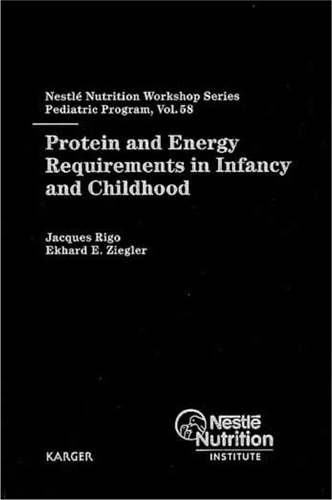58th Nestlé Nutrition Workshop, Pediatric Program, Ho Chi Minh City, Vietnam, November 2005.Jacques Rigo and Ekhard E. Ziegler, eds. Karger. Vol 58, 230 pp.ISBN 3-8055-8081-9. EUR 163.
The book highlights feeding during the first years of life and the consequences for health.
The first section deals with “Requirements for protein and energy”. Metabolic programming, i.e. the long-term consequences of early feeding on later obesity risk, is discussed by Berthold Koletzko. Breast-feeding might lower the risk of obesity at school age. Since infant formula with an energy and protein content in excess of requirements stimulates the secretion of insulin and insulin growth factor-1 (IGF-1), which can accelerate growth during the first 2 years of life and increase the risk of developing obesity.
Nancy Butte gives current data on the energy requirements of infants and children up to the age of 18 years. The use of the double-labelled water method has provided new total energy expenditure data to derive energy requirements. In comparison to earlier data, the energy need is 18–20% lower for infants and children less than 7 years old, whereas the requirements for adolescents have increased.
In the section “Body composition and growth”, Ekhard Ziegler describes the growth of breast-fed and formula-fed infants. The protein intakes of formula-fed infants after the first 2 months exceeded requirements, explaining the differences in growth between the two groups. Body composition during the first year of life is reviewed by Jacques Rigo. Dual X-ray absorptiometry (DXA) is considered to be the best technique to evaluate body composition, although the DXA instruments have measurement differences.
The following chapter, by Allison Yates, deals with dietary reference intakes, a difficult task, particularly if the long-term consequences of nutrient recommendations in infancy and childhood should be taken into account.
The third section overviews “High intakes of protein and amino acids”, including amino acid metabolism in neonates (Johannes van Gouchever), amino acid requirements of infants and children (Paul Pencharz) and the effects of high intakes of protein (Irene Axelssson). During the weaning period the protein intake increases remarkably to 3–4 g kg-1 per day, whereas the requirement for protein decreases. Currently, the long-term consequences of this loading are unknown.
The section “Complementary foods” summarizes the physiology of food intake (Harvey Anderson) and complementary foods (Carlo Agostoni), and the optimal age for the introduction of complementary foods (Kathryn Dewey). Very limited data are available on the physiological interaction between dietary components and physiological control mechanisms. The high energy percentage from proteins in complementary foods may predispose to early overweight and obesity development.
The last section has the title “New proteins in infant feeding”, starting with the huge problem of malnutrition in developing countries, reviewed by Jehan-Francois Desjeux. Breast-feeding is life saving, and complementary feeding requires nutrient-dense foods. Home-based therapy not using water, sometimes called ready-to-use therapeutic food, and community therapeutic care have proved to be successful in the treatment of malnutrition. Dairy technology is reviewed by Katherine Macé. The protein content in infant formulae has been decreased and is today closer to that of breast milk.
The final chapter, presented by Bo Lönnerdal, describes the incorporation of recombinant human milk proteins, lactoferrin and lysozyme, into rice. The components are purified and heat resistant, and have biological activities identical to the corresponding human milk proteins. It has also been possible to add recombinant human lactoferrin and lysozyme to the WHO oral rehydration solutions. Maybe, in the future, bioactive factors will be added to infant formula and baby food.
The proceedings of the meeting should be of interest to paediatricians, nutritionists and health personnel. Most of the tables and figures are useful, and there is a comprehensive reference list at the end of each chapter. The discussion sections after each chapter are most valuable to the reader.
